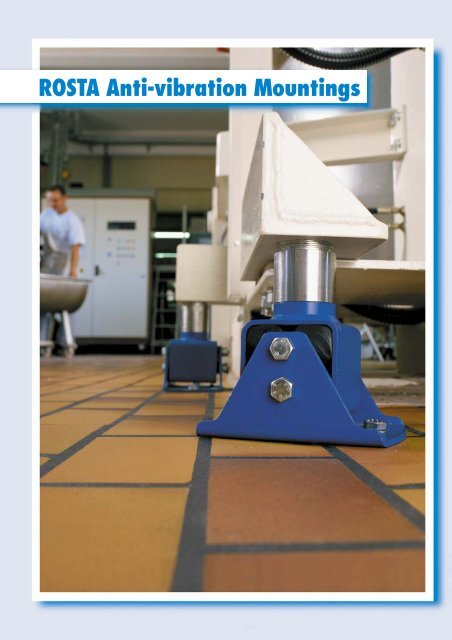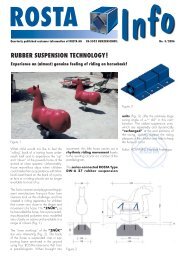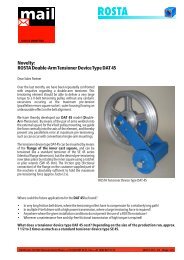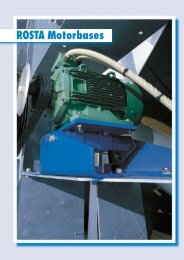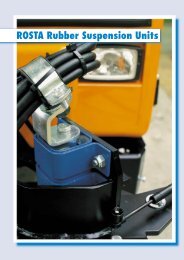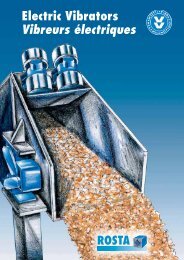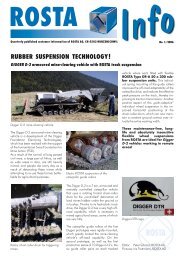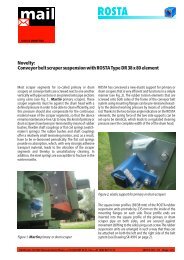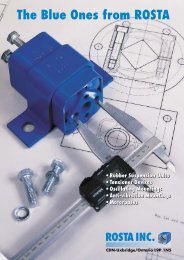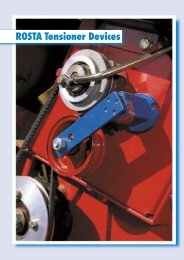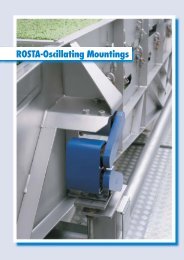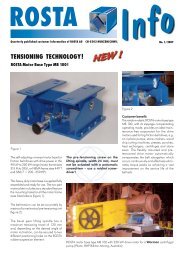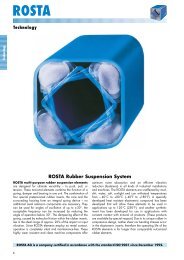ROSTA Anti-vibration Mountings - ROSTA Inc.
ROSTA Anti-vibration Mountings - ROSTA Inc.
ROSTA Anti-vibration Mountings - ROSTA Inc.
You also want an ePaper? Increase the reach of your titles
YUMPU automatically turns print PDFs into web optimized ePapers that Google loves.
<strong>ROSTA</strong> <strong>Anti</strong>-<strong>vibration</strong> <strong>Mountings</strong>
<strong>ROSTA</strong><br />
Technology<br />
With a relatively hard machine support or mounting, the<br />
amplitude of the installed equipment is minimal, but the<br />
resulting isolation efficiency is much less than with a more<br />
resilient mounting. Although technically the isolation efficiency<br />
of a soft mounting is very high, it impairs the<br />
machine stability and can lead to uncontrolled operation of<br />
the installation (example: distorted frames on production<br />
machines). Hence, for the machine type in question, an ideal<br />
compromise must be sought between the level of the isolation<br />
efficiency and permissible spring deflection. As a general<br />
rule the mountings of machine tools, machining centers etc.<br />
should be hard whilst those for equipment such as compressors,<br />
generators and pumps etc. should be relatively<br />
soft. Rubber as an elastic medium is probably the most<br />
universal material used for <strong>vibration</strong>al damping.<br />
Time<br />
Steel spring<br />
(no self-damping)<br />
Rubber spring<br />
(self-damping)<br />
Its special properties render it particularly suitable for damping<br />
and springing elements. Rubber elements can accept<br />
considerable overloads for a short time without suffering any<br />
damage. In contrast to steel springs, under dynamic loading,<br />
rubber elements convert the energy absorbed into heat by<br />
internal molecular friction.<br />
This process – known as damping – is continuous and it is<br />
always required whenever resonance can occur or shocks<br />
have to be reduced quickly.<br />
Two basically different types of rubber loading were made<br />
use of in the design of <strong>ROSTA</strong> anti-<strong>vibration</strong> mountings:<br />
– pure tensile or pressure loading for the anti-<strong>vibration</strong><br />
mountings of the types V, ISOCOL and N. These relatively<br />
simple elements cover the medium natural frequency band<br />
between 15 and 30 Hz.<br />
– loading via lever of pretensioned rubber elements by<br />
torsional or flexing motion of the <strong>ROSTA</strong> rubber suspension<br />
units in so-called spring dampers. This system allows<br />
the construction of anti-<strong>vibration</strong> mountings in the low<br />
frequency range between 2 and 10 Hz. These are types<br />
ESL and AB.<br />
The following survey of the entire product range shows the<br />
advantages and applications of the various types. For<br />
complex applications and in the case of queries, do not<br />
hesitate to get in touch with us – our technical service<br />
department is at your disposal.<br />
Superior Technology<br />
<strong>Anti</strong>-<strong>vibration</strong> <strong>Mountings</strong><br />
isolating<br />
in all directions<br />
wide<br />
frequency range<br />
self adhesive<br />
on both sides<br />
efficient<br />
absorption<br />
free standing<br />
or mounting by bolts<br />
unique<br />
levelling system<br />
72
<strong>ROSTA</strong><br />
Technology<br />
Oscillations<br />
Shocks<br />
Isolation of Vibrations<br />
and Solid-borne Noise<br />
There are basically three different forms of <strong>vibration</strong>, as<br />
shown in fig. 1.<br />
The overcritical type of mounting is used for isolating <strong>vibration</strong>s<br />
and tremors, while for isolating shocks the subcritical<br />
type of mounting is generally employed.<br />
Tremors<br />
Overcritical:<br />
Interfering frequency (machine)<br />
Natural frequency (damper)<br />
= > 1<br />
Fig. 1<br />
Subcritical:<br />
Interfering frequency (machine)<br />
Natural frequency (damper)<br />
= < 1<br />
√ 2<br />
0<br />
Frequency ratio λ<br />
1,5 1,6 1,8 2,2 3 10<br />
15 30 45 60 75 90 %<br />
Degree of isolation η<br />
Interfering frequency (machine)<br />
λ = Fig. 2<br />
Natural frequency (damper)<br />
Mechanical Vibrations<br />
The basic principle of <strong>vibration</strong> isolation technique is to<br />
isolate the source of interference, or the object to be protected,<br />
from its surroundings. This is achieved by suitable<br />
frequency adaption – the higher the frquency ratio, the<br />
higher the degree of isolation. See fig. 2.<br />
Acoustic isolation ratio Steel 1 : 1<br />
related to steel: Bronze 1 : 1.3<br />
Cork 1 : 400<br />
Rubber 1 : 800<br />
Air 1 : 90000<br />
Fig. 3<br />
Absorption<br />
of Solid-borne Noise<br />
While interference forces are isolated on the basis of<br />
<strong>vibration</strong>al theory, the isolation of sound transmission<br />
through solid-borne bodies is governed by the laws of wave<br />
mechanics. The isolation efficiency depends on the acoustic<br />
stiffness of the contacting materials between machine and<br />
structure. The table in fig. 3 shows the absorption efficiency<br />
of some material. A steel rubber compound normally offers a<br />
highly efficient isolation of the solid-borne noise.<br />
Amplitude Load<br />
Deflection<br />
Time space<br />
Loading<br />
Loss of energy<br />
per cycle<br />
Unloading<br />
Fig. 4<br />
Fig. 5<br />
Damping<br />
In the <strong>ROSTA</strong> type mounts is damping a function of the internal<br />
molecular friction in the rubber material during oscillation<br />
and <strong>vibration</strong>. The resulting energy loss is converted<br />
into heat during the <strong>vibration</strong> process. The area (fig.4)<br />
bertween the loading and unloading curves corresponds<br />
to the energy loss or damping in the <strong>ROSTA</strong> elements.<br />
In practice, the damping characteristic becomes important<br />
when the <strong>vibration</strong>s of an elastically supported machine is<br />
passing through the resonance field and an oscillation<br />
could build up. The natural isolation properties of the<br />
<strong>ROSTA</strong> anti-<strong>vibration</strong> mountings limit this build-up to a<br />
minimum due to the high energy loss. Vibrations are<br />
absorbed as soon as they occur.<br />
The amplitude/time characteristic demonstrates the high<br />
efficiency of the rubber damping material.<br />
<strong>Anti</strong>-<strong>vibration</strong> <strong>Mountings</strong><br />
73
<strong>ROSTA</strong><br />
Technology<br />
Natural Frequency<br />
of the Vibration Damper<br />
300<br />
Natural frequency n e =<br />
= min –1<br />
√s (in cm)<br />
5<br />
or<br />
= Hz<br />
√s (in cm)<br />
Fig. 6<br />
Even simple applications require some elementary knowledge<br />
of <strong>vibration</strong> isolation. An important factor in this<br />
connection is the natural frequency of the damper which is<br />
measured in rpm or Hz, i.e. the number of oscillations per<br />
minute or second which lead to resonance excitation.<br />
The natural frequency n e is a function of the spring travel s<br />
(cm) under a load G (N) and can be calculated from the<br />
formula given in fig. 6.<br />
<strong>Anti</strong>-<strong>vibration</strong> <strong>Mountings</strong><br />
Load F in N<br />
transmitted power<br />
excited power<br />
Transmissibility V =<br />
Ordinate<br />
2<br />
1<br />
0.8<br />
0.6<br />
0.4<br />
0.2<br />
assumed load F<br />
sub-critical<br />
function<br />
(20%)<br />
(40%)<br />
(60%)<br />
(80%)<br />
Proportion of frequency λ = n err<br />
n e<br />
Time range in sec.<br />
Tangent<br />
Pitch of spring s<br />
Damping<br />
S 1<br />
1<br />
1 √2<br />
3 4 5<br />
First deflection<br />
under load<br />
overcritical<br />
function<br />
D=1.0<br />
D=0.25<br />
D=0<br />
1st day<br />
Abscissa<br />
Isolation range<br />
Cold flow<br />
1st year<br />
Fig. 7<br />
Fig. 8<br />
6 6x10 1 6x10 2 6x10 3 6x10 4 6x10 5 6x10 6 6x10 7<br />
A<br />
Fig. 9<br />
Natural Frequency with Parabolic Spring<br />
Characteristic<br />
It is only with <strong>vibration</strong> dampers comprising steel springs that<br />
the damper’s natural frequency can be derived directly from<br />
the measured spring travel according to the formula in fig. 6.<br />
Steel springs have a linear characteristic and hence a spring<br />
constant. But they have no damping and are only suitable for<br />
pure swing mountings.<br />
All other damping materials such as rubber, cork etc., are<br />
deformed under load and the effective measured spring<br />
travel is greater than the actual resulting natural frequency.<br />
Rubber springs have a slightly parabolic characteristic and<br />
the natural frequency resulting from the applied load is<br />
therefore essentially higher than the calculated value in<br />
conformity with the spring travel (fig. 7: s 1 determines the<br />
frequency). The following catalogue frequency values are<br />
measured and derived from the s 1 spring travel.<br />
Hence the natural frequency values must lie outside the<br />
resonance field. An undesirable build-up of <strong>vibration</strong>s is<br />
likely to occur wherever the exciting frequency n err and<br />
natural frequency n e are the same.<br />
λ < 1:<br />
λ = 1:<br />
λ >√2:<br />
damping is not exactly definable and solid-borne<br />
noise isolation is reduced<br />
oscillation build-up, peak values depending on selfdamping<br />
D within the resonance field<br />
<strong>vibration</strong> isolation efficiency h dependent on l, also<br />
efficient solid-borne noise isolation<br />
Cold Flow<br />
During the course of time, all elastic materials deform more<br />
or less permanently under load, which becomes apparent<br />
by a slight increase in deflection and cold flow. This cold<br />
flow exhibits a linear characteristic on a logarithmic time<br />
base. The diagram in fig. 9 shows that more than half of<br />
the total cold flow occurring in one year has taken place<br />
after loading for one day. The max. setting of <strong>ROSTA</strong> anti<strong>vibration</strong><br />
mountings is approx. +10% of the nominal<br />
spring travel according to the catalogue.<br />
74
<strong>ROSTA</strong><br />
Technology<br />
Active isolation<br />
Active and Passive Isolation<br />
In practice, elastic intermediate supports or mountings are installed<br />
for two different reasons:<br />
Practical Considerations<br />
The use <strong>vibration</strong> damping machine mountings and supports<br />
permits continuously flexible installation of a machine line.<br />
Conventional floor anchorages can be almost totally dispensed<br />
with and the machines rapidly and simply converted to<br />
new production sequences. Furthermore, the normally standard<br />
integrated levelling facilities are a simple way to compensate<br />
for uneven floor surfaces.<br />
Fig. 10<br />
Passive isolation<br />
Fig. 11<br />
Protective Considerations<br />
Personnel, environment, building structure and the machines<br />
themselves are efficiently protected by the <strong>vibration</strong><br />
compensating machine supports. Vibrations and shocks<br />
are considerably reduced and the working environment<br />
improved.<br />
Active or direct isolation signifies the damping of the<br />
<strong>vibration</strong>s and shocks from an operating machine, i.e. to prevent<br />
<strong>vibration</strong>s being transferred to foundation, adjacent<br />
rooms, building etc. To be taken into account in each case<br />
here are the interfering frequency, the machine structure and<br />
its site. This is the most frequent type of <strong>vibration</strong> isolation<br />
and occurs in almost all factories or households.<br />
Passive or indirect isolation signifies the shielding<br />
of sensitive equipment such as weighing and measuring instruments,<br />
laboratory appliances etc. from <strong>vibration</strong>s<br />
and shocks. Here the technical requirements can be highly<br />
dependent on the environment since interference is often external<br />
in origin; from the street, railways or large building<br />
sites. The assistance of the specialist engineer is frequently<br />
necessary to define this spectrum.<br />
A, B, C, D Mounting points of anti-<strong>vibration</strong> mountings<br />
S Center of gravity<br />
Fig. 12<br />
Fig. 12<br />
Defining the Supporting<br />
Forces<br />
a) Position of <strong>ROSTA</strong> anti-<strong>vibration</strong> mountings<br />
on/under the machine frame<br />
Install all elements so that the loading or spring travel is<br />
uniform. Whenever – as so often in practise – asymmetric<br />
center of gravity circumstances and hence differing loads<br />
and spring travels are encountered, the supporting forces<br />
can be determined according to fig. 12. In such cases, differences<br />
in spring travel are to be equalized with the aid of<br />
spacer plates.<br />
b<br />
Load on point A = S · d – c<br />
B = S a – b · d – c<br />
a d<br />
a d<br />
b<br />
C = S ·<br />
c<br />
D = S a – b ·<br />
c<br />
a d a d<br />
<strong>Anti</strong>-<strong>vibration</strong> <strong>Mountings</strong><br />
75
<strong>ROSTA</strong><br />
Product Range<br />
<strong>ROSTA</strong> <strong>Anti</strong>-<strong>vibration</strong> Mounting<br />
Type ESL<br />
Page 77<br />
<strong>ROSTA</strong> anti-<strong>vibration</strong> mountings type ESL are intended for the<br />
absorption of medium and low frequency <strong>vibration</strong>s and are designed<br />
to accept compression, tension and shear loading as well as<br />
combined loadings. They can be installed in any desired position<br />
and are also ideal for ceiling and wall mounting. Due to the<br />
mechanically secured principle of the anti-<strong>vibration</strong> mountings type<br />
ESL no tearing off is possible. These elements are maintenancefree,<br />
insensitive to water and dirt and suitable for temperatures<br />
from – 40 to + 80°C. The housing and core of the elements up to<br />
size 45 are made of light alloy with steel brackets. The housing of<br />
size 50 is made of GGG 40. All elements are paint-finished.<br />
<strong>ROSTA</strong> <strong>Anti</strong>-<strong>vibration</strong> Mounting<br />
Type V<br />
Page 78<br />
<strong>ROSTA</strong> anti-<strong>vibration</strong> mountings type V are multi-directional<br />
dampers and are designed to accept compression, tension and<br />
shear loading as well as combined loadings. They can be installed<br />
in any desired position and are also ideal for ceiling and wall<br />
mounting. Due to the mechanically secured principle of the anti<strong>vibration</strong><br />
mountings type V no tearing off is possible. These elements<br />
are maintenance-free, insensitive to water and dirt and<br />
suitable for temperatures from – 40 to + 80 °C. The core is made of<br />
light alloy, the outer housing and brackets of steel. All elements are<br />
paint-finished.<br />
<strong>Anti</strong>-<strong>vibration</strong> <strong>Mountings</strong><br />
<strong>ROSTA</strong> Adhesive Isolation Plate<br />
Type ISOCOL<br />
<strong>ROSTA</strong> <strong>Anti</strong>-<strong>vibration</strong> Mounting<br />
Type ISOCOL U<br />
The <strong>ROSTA</strong> adhesive isolation plate type ISOCOL is a highly<br />
efficient damping element. The plate is self-adhesive and resistant to<br />
oils and chemicals. It is made of 3 layers, and suitable for<br />
temperatures from – 40 to + 80 °C. The plate can be fixed on the<br />
floor or on machine frames by simply removing the protective foil on<br />
both sides of the plate. The adhesiveness of the element can even<br />
be increased by wetting the plate with a nitro thinner.<br />
The anti-<strong>vibration</strong> mounting type ISOCOL U consists on an extra<br />
cover plate made of grey cast iron. The notch in the centre of<br />
the cover plate facilitates the mounting of a possible levelling screw.<br />
However, it is also possible to use the retaining edge for lateral<br />
guidance of the machine frame, which doesn’t require any<br />
additional fixing.<br />
<strong>ROSTA</strong> <strong>Anti</strong>-<strong>vibration</strong> Mounting<br />
Type N/NP<br />
Page 79<br />
Page 80<br />
The <strong>ROSTA</strong> anti-<strong>vibration</strong> mounting type N consists of an isolating<br />
plate with a bonded metal cover and a levelling screw. This special<br />
levelling system is screwed directly into the machine frame. It can be<br />
adjusted from the side. The connection link between the cover and<br />
the levelling screw compensates for slightly sloping floors (up to<br />
about 3°). The adhesive isolating plate is resistant to oils and chemicals.<br />
It is suitable for temperatures of – 40 to + 80 °C. The<br />
levelling screw with lock nut is galvanised, the cover plate is made<br />
of grey cast iron.<br />
Type NP is additionally equipped with a bonded aluminium floor<br />
plate. This additional base plate for floor fixing is required in case<br />
of excessive lateral motions.<br />
76
<strong>ROSTA</strong><br />
<strong>Anti</strong>-<strong>vibration</strong> Mounting<br />
Type ESL<br />
Multi-directional mount<br />
for compression, tension<br />
and shear loading<br />
Load in N<br />
A<br />
un-<br />
A<br />
max. X Weight<br />
Art. No Type on axes Z ÷ Z loaded load B C D E ØF H J K L N max. in kg<br />
05 021 001 ESL 15 – 400 54 44 85 49 10 65 7 90.5 2 5.5 25.5 58.5 1.54 0.36<br />
05 021 002 ESL 18 300 – 1200 65 52 105 60 12.5 80 9.5 110.5 2.5 5.5 31 69 1.87 0.62<br />
05 021 003 ESL 27 1000 – 2000 88 72 140 71 15 110 11.5 148 3 8 44 85.3 2.65 1.28<br />
05 021 004 ESL 38 1800 – 3500 117 93 175 98 17.5 140 14 182 4 7 60 117 3.62 3.40<br />
05 021 005 ESL 45 3200 – 6000 143 115 220 120 25 170 18 234.5 5 14.5 73 138 4.40 5.25<br />
05 021 006 ESL 50 5500 – 9000 165 134 225 142 25 175 18 240 6 15 78.5 163 4.73 10.00<br />
The max. load on X ÷ X axes is the double value from Z ÷ Z axes.<br />
The max. load on Y ÷ Y axes is 20% from Z ÷ Z axes.<br />
Applications<br />
For active and passive isolation of <strong>vibration</strong>s and maximum<br />
damping of solid-borne noise transmission in: weighbridges<br />
and scales, measuring systems, control equipment, rotary<br />
machinery such as compressors, refrigerating systems,<br />
blowers, pumps, mills, mixers, shock-absorbent buffers, etc.<br />
Fig. a<br />
The elements must generally be<br />
installed in the same direction<br />
Fig. a) Dynamic forces longitudinal<br />
Fig. b) Dynamic forces lateral<br />
Fig. c) Wall mounting<br />
For installation guidelines see<br />
Load on compression in N<br />
Load capacity<br />
f Natural frequency in HZ<br />
Fig. b<br />
Load on compression in N<br />
Load capacity<br />
f Natural frequency in HZ<br />
Fig. c<br />
<strong>Anti</strong>-<strong>vibration</strong> <strong>Mountings</strong><br />
Deflection in mm<br />
Deflection in mm<br />
77
<strong>ROSTA</strong><br />
<strong>Anti</strong>-<strong>vibration</strong> Mounting<br />
Type V<br />
Type V 15 – 45 Type V 50<br />
Multi-directional mount<br />
for compression, tension<br />
and shear loading<br />
Alternativ<br />
mounting position<br />
Load in N<br />
Weight<br />
Art. No Type on axes X ÷ X; Z ÷ Z A B C D E ØF M N H ØJ K in kg<br />
05 011 001 V 15 1300 – 2 800 49 80 51 12.5 55 9.5 M 10 58.5 3,0 20 10,0 0.30<br />
05 011 002 V 18 1600 – 1600 66 100 62 12.5 75 9.5 M 10 74,0 3.5 30 13,0 0.70<br />
05 011 003 V 27 1300 – 3000 84 130 73 15,0 100 11.5 M 12 85.3 4,0 40 14.5 1.25<br />
05 011 004 V 38 2600 – 5000 105 155 100 17.5 120 14,0 M 16 117,0 5,0 45 17.5 2.45<br />
05 011 005 V 45 4500 – 8000 127 190 122 25 140 18,0 M 20 148,0 6,0 60 22.5 4.64<br />
05 011 006 V 50 6000 – 12000 150 140 150 20 100 M 20 262,0 10,0 70 25,0 7.46<br />
The max. load on Y ÷ Y axes is 10% from Z ÷ Z and X ÷ X axes.<br />
Momentary shock loads of 2.5 g in Z ÷ Z and X ÷ X axes are admissible.<br />
Applications<br />
For active and passive isolation of <strong>vibration</strong>s and damping<br />
of solid-borne noise transmission in crushing plants, compressors,<br />
blowers, pumps, rotary converters, generators,<br />
mills, crane track supports, etc.<br />
Fig. a<br />
Fig. b<br />
<strong>Anti</strong>-<strong>vibration</strong> <strong>Mountings</strong><br />
For installation guidelines see<br />
Load on compression in lbs.<br />
Load capacity<br />
Natural frequency in Hz<br />
Fig. c<br />
Load on compression in lbs.<br />
Load capacity<br />
Natural frequency in Hz<br />
Fig. a) Dynamic forces<br />
longitudinal<br />
Fig. b) Dynamic forces<br />
lateral<br />
Fig. c) Dynamic forces<br />
undeterminant<br />
Deflection in mm<br />
Deflection in mm<br />
78
➡<br />
<strong>ROSTA</strong><br />
<strong>Anti</strong>-<strong>vibration</strong> Mounting<br />
Type ISOCOL/ISOCOL U<br />
ISOCOL<br />
ISOCOL U<br />
➡<br />
ISOCOL<br />
Weight<br />
Art. N o Type Load A B<br />
in kg<br />
05 030 001 ISOCOL 50 1200 N – 1500 N 50 8 0.02<br />
05 030 002 ISOCOL 80 1200 N – 3800 N 80 8 0.05<br />
05 030 003 ISOCOL 400 20 - 60 N/cm 2 400 8 1.30<br />
ISOCOL U<br />
Weight<br />
Art. N o Type Load A B C D E<br />
in kg<br />
05 040 001 ISOCOL U 50 1200 N – 1500 N 60 14 3 11 2 0.15<br />
05 040 002 ISOCOL U 80 1200 N – 3800 N 90 15 3 14 2 0.40<br />
Installation Guidelines<br />
In order to obtain optimal stabilisation of the<br />
machine, it is recommended to allow the ISO-<br />
COL plates to protude approx. 10 mm from the<br />
machine base. The single plates must be mounted<br />
such that the load is evenly distributed.<br />
Applications<br />
For extremly low heights, for the damping of<br />
<strong>vibration</strong>s and solid-borne noise transmission in<br />
substructures and building such as air conditioning<br />
plants, heating boilers, pumps, office<br />
machines, computer systems, laboratory<br />
equipement, wood working machines and<br />
workshop equipement etc.<br />
In case there is no levelling necessary it is possible<br />
to push the ISOCOL U elements directly<br />
under the machine base, up to the retaining<br />
edge. Additional fixation is not necessary.<br />
Load in N/cm 2<br />
Load capacity<br />
Natural frequency in Hz<br />
ISOCOL<br />
In case the element includes a levelling screw,<br />
the ISOCOL U mounting is placed directly on<br />
the notch in the centre of the base plate, which<br />
allows the element to be levelled.<br />
Load in N<br />
Load capacity<br />
Natural frequency in Hz<br />
ISOCOL U<br />
<strong>Anti</strong>-<strong>vibration</strong> <strong>Mountings</strong><br />
Remarks<br />
The customer is free to make tailor-made sizes<br />
from the ISOCOL 400 plates (400x400 mm).<br />
Standardised sizes are available.<br />
Deflection in mm<br />
Deflection in mm<br />
79
<strong>ROSTA</strong><br />
<strong>Anti</strong>-<strong>vibration</strong> Mounting<br />
Type N/NP<br />
Type N<br />
Type NP<br />
Weight<br />
Art. No Type Load in N A B C D E F G H I K SW in kg<br />
05 050 001 N 70 M 12 – 2500 80 27 80 M 12 36 19 0.50<br />
05 050 002 N 70 M 16 – 2500 80 30 120 M 16 40 24 0.60<br />
05 050 003 N 71 M 16 2000 – 4000 80 30 120 M 16 40 24 0.60<br />
05 050 004 N 120 M 20 2000 – 6000 128 36 120 M 20 48 30 1.56<br />
05 050 005 N 121 M 20 5000 – 12000 128 36 120 M 20 48 30 1.56<br />
05 060 001 NP 70 M 12 – 2500 80 30 80 M 12 39 84 110 140 4 12 19 0.60<br />
05 060 002 NP 70 M 16 – 2500 80 33 120 M 16 43 84 110 140 4 12 24 0.70<br />
05 060 003 NP 71 M 16 2000 – 4000 80 33 120 M 16 43 84 110 140 4 12 24 0.70<br />
05 060 004 NP 120 M 20 2000 – 6000 128 40 120 M 20 52 135 170 210 5 16 30 1.80<br />
05 060 005 NP 121 M 20 5000 –12000 128 40 120 M 20 52 135 170 210 5 16 30 1.80<br />
Applications<br />
For damping <strong>vibration</strong>s and solid-borne noise transmission<br />
in machinery and apparatus also requiring leveling, such<br />
as: air conditioning plants, woodworking machinery,<br />
pumps, transport systems, light tooling machines, assembly<br />
lines and workshop equipment.<br />
Remarks<br />
These elements are identifiable by the dark blue isolating<br />
plate of the N 70 and N 120 anti-<strong>vibration</strong> mountings and<br />
the light blue plate of the N 71 and N 121 anti-<strong>vibration</strong><br />
mountings.<br />
Installation Guidelines<br />
<strong>Anti</strong>-<strong>vibration</strong> <strong>Mountings</strong><br />
Load in N<br />
Load capacity<br />
Natural frequency in Hz<br />
Leveling screw should be fixed directly in the machine frame<br />
and adjusted from the side. The baseplate (Type NP) allows<br />
a floor fixation in case of lateral motions.<br />
Deflection in mm<br />
80
<strong>ROSTA</strong><br />
<strong>Anti</strong>-<strong>vibration</strong> Mounting<br />
Type Nox<br />
8 o 8 o<br />
D<br />
C<br />
B<br />
E min.<br />
sw<br />
ØA<br />
Natural<br />
Weight<br />
Art. N o Type Load in N frequency A B C D E sw in kg<br />
05 080 002 NOX 70 M 16 – 4000 18–22 76 28 120 M 16 38 19 0.50<br />
05 080 003 NOX 120 M 20 4000 –12000 18–22 115 36 120 M 20 48 24 0.60<br />
The <strong>ROSTA</strong> anti-<strong>vibration</strong> mountings type NOX 70 M16 and<br />
NOX 120 M20 have been developed especially for the<br />
food processing industry and the chemical process<br />
technology. Their levelling system is equipped with a<br />
spherical socket joint made of stainless steel DIN 1.4301 /<br />
AISI 304 and is able to compensate a ground uneveness of<br />
up to 8 o . The covering plate, which is made of the same<br />
material, is screwed to the levelling system and surrounds<br />
the oil- and acid-resistant anti-<strong>vibration</strong> plate made of<br />
synthetic rubber material. The non-skid machine support<br />
with a natural frequency of 18 to 22 Hz offers best active<br />
<strong>vibration</strong> dampening and is thus very useful for supporting<br />
processing machines of various kinds such as mixing and<br />
stirring machines, filling plants, passing machines, mills,<br />
conveyors, and kneading machines.<br />
Installation Guidelines<br />
Load in N<br />
Load capacity<br />
Natural frequency in Hz<br />
<strong>Anti</strong>-<strong>vibration</strong> <strong>Mountings</strong><br />
The leveling screw of the anti-<strong>vibration</strong> mounting type NOX<br />
should be fixed directly in the machine frame and adjusted<br />
from the side.<br />
Deflection in mm<br />
81
<strong>ROSTA</strong><br />
Installations<br />
Hydraulic pump on type V (wall fixation) Chain feeder on type V Belt conveyor suspension with type V<br />
(ceiling fixation)<br />
Assembling robot on type N<br />
Assembling line on type N<br />
<strong>Anti</strong>-<strong>vibration</strong> <strong>Mountings</strong><br />
Continuous newspaper folding machine on type N<br />
Air compressor on type V<br />
82


